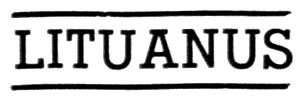
December, 1958 Vol. 4, No. 4
Managing Editor P. V. Vygantas
 |
www.lituanus.org |
| Copyright
© 1958 Lithuanian
Students Association, Inc. December, 1958 Vol. 4, No. 4 Managing Editor P. V. Vygantas |
|
PETRAS KIAULĖNAS AND THE ART OF MODERN COLOR
GORDON BROWN
GORDON
BROWN, President of the Society of Young American Artists, is an art
lecturer at Hunter College, New York City.
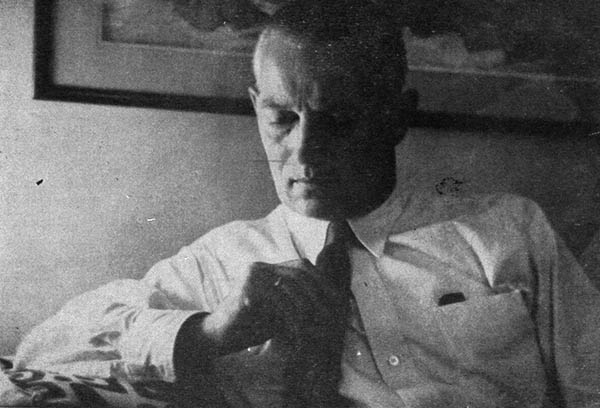 |
| PETRAS KIAULĖNAS (Last picture before the artist's death in 1954). |
The distinguished Lithuanian painter,
Petras Kiaulenas, continued to explore the possibilities of color up to
his death in 1954. Were it not for the developments in his methods of
coloring achieved in the United States, where he spent the final years
of his life, it would be presumptuous to add anything to the important
body of criticism already built up around his work by Parisian art
critics in the 1940's. Kaiulenas' ideas and achievements in the domain
of color go beyond impressionism, as it was formerly understood, and
fairly demand a new critical treatment.
The possibility of creating a modern school of impressionism has always
seemed intriguing. Kiaulenas has laid the foundation for such a
development. To-day, scientific color theory has been reconstituted and
new ideas are in the air. A similar situation existed when the older
impressionism appeared simultaneously with new developments in the
theory of color. According to Paul Signac, the influence of the French
scientist Chevreul was decisive on the work of Seurat, Cross, and
Signac. Chevreul's book appeared in 1839, many years before Monet or
Picasso ever exhibited. The real artistic contemporary of Chevreul was
Eugene Delacroix, who inspired impressionism and developed his own
color theories independently.
It is not surprising that, paraleli to contemporary scientific
developments, an artist of the stamp of Kiaulenas has appeared. Without
reference to any books he is making his own empirical discoveries. Most
amazing to me has been his fhnd that the direction or curvature of
brush strokes influence the hue, intensity and value of color. Of
course, this phenomenon takes place when the strokes are visible and
separated, as they always are in Kiaulenas' work. If I may be pardoned
a continued emphasis on science, I should like to point out a parallel
to KiaulSnas' use of curving brush strokes. Plate XII in Faber Birren's
recent book, MONUMENT TO COLOR, shows how the pure colors of the
spectrum laid out in waving bands, one above another, appear to
overlap, when seen at a dixtance, and to develop a glow approximating
the luminosity of the rainbow. Now it is precisely this spctrum glow,
obtained with the merely material colors and stains of the painter,
that marks the style of Petras Kiaulenas and makes his work different
from that of any other artist. Here I may safely appeal to the
observations of any one standing before a Kiaulenas original. His reds
and oranges really do glow to an unusual degree.
It will be found that any given red area in one of Kiaulenas' paintings
is generally composed of different kinds of reds, some veering toward
orange and others toward violet. To-day we know that a glow, such as
Kiaulenas obtained, comes from just such a juxtaposition of similar
hues and not from the juxtaposition of nearly complementary hues. This
latter type of juxtaposition was considered basic by the older
impressionists, since they believed that all colors derived from
mixtures of red, yellow and blue, which are different rather than
similar colors. Such juxtapositions they usually obtained.
Nevertheless, there is some truth in the impressionist idea that pure
colors, laid side by side in the form of dots, crcate a lively effect.
At the risk of going into too much detail, I may say that the
juxtaposition of approximately complementary colors is lively only when
viewed close up while a longer view of the whole appears dull. This
longer view is the one obtained when, for example, you look at a whole
picture by Claude Monet. Kiaulenas almost invariably used his reds as
dominants and these have a luminosity impossible to obtain by blindly
following the principles of Monet, Pissaro and Seurat.
To sum up, both Kiaulenas and modern color science use the principle of
similar hues and wavy lines rather than dots to produce maximum
luminosity. But unlike the scientist, Kiaulenas has enlisted all the
other resources of the painter's craft to produce his glow. If
necessary, in order to subordinate certain areas, Kiaulenas has
resorted to the older impressionist method of complementary
juxtaposition. In this way he interweaved his reds with the cool colors
throughout the canvas so that the picture as a whole radiates with
extraordinary warmth. His dazzling effects have been largely developed
from the very materials he used. It is as if the pigments and the
brushes had talked to him and he had followed their suggestions, always
taking into consideration his own personality and way of handling his
tools. Kiaulenas' art of color developed spontaneously and creatively
from his own way of seeing and feeling paint rather than from the
application of any arbitrary and limited scientific theory. For this
reason the parallel with the modern scientific viewpoint sems even more
surprising.
Yet such parallels constantly confront the art historian. The various
cultural manifestations of an epoch, however independent of one another
they may seem at first glance, almost always converge towards an
historically determined ideal. Thus, Kiaulenas' art has been partly
determined by the course of history. His style has evolved from
historic impressionism in response to a continued interest in color and
light in our own times.
But the changes that Kiaulenas has wrought in the impressionist style
require a more complete enumeration. Compared to Monet, his brush
strokes are freer and more active. Compared to Seurat, his style is
less determined by A PRIORI rules or preestablished points of view.
Compared to either, his color is more luminous. Moreover, Kiaulenas
technique is mere complex and varied than that of the older
impressionists. Seeking greater purity and freshness, he often used
touches of impasto which barely graze the canvas or perhaps,
transparent, fluid strokes which let the canvas show through. All this
gives the light and airy quality of film color to his pictures. Above
all Kiaulenas sought for clear color whereas the average impressionist
canvas, with its monotonous repetition of solid, similarly shaped brush
marks, appear heavy and opaque. Kiaulenas thus obtained a purity of
effect whereas, for Monet and Seurat, purity meant intensity of hue and
the absence of dirty mixtures. Kiaulenas, of course, also used the
concept. At times, too, he will crush a heavy Impasto onto the grain of
the canvas, obtaining either solid or crumbling effects. His varied
touches are usually criss-crossed since he used curved, horizontal,
vertical and diagonal strokes. I have mentioned his idea that the
direction of those strokes affect the color. Hence, Kiaulenas has
consciously integrated calligraphy and color. Whereas classical
painting used line to get contour. Kiaulenas used line to get color.
This gives a new twist to a 300 year old argument over the respective
merits of line drawing and of color, which was formerly the chief
preoccupation of the eminent members of the Royal Academy of Painting
in Paris. Kiaulenas would have shocked the older academicians for he
avoids contour lines in the ordinary sense of the word. It is not
contour but beautiful relationships between an infinity of tones and
colors that Kiaulenas sought.
This extraordinary variety, particularly in kinds of brush strokes
contributes to his luminous glow. We have already seen that waving
lines of spectrum colors produce an overlapping in the eye of the
spectator looking at Plate XII in Faber Birren's book. The spectator's
eye is confused and he sees what really is not there, an optical rather
than a physical mixture of printing inks. In similar fashion, Kiaulenas
varied brush strokes produce an artful confusion and feeling of
overlaps. Such is the variety of his touch that his color indicates,
not the color of an object, but the color of light itself, which is
intangible. In this way, Kiaulenas continued impressionism with a
modern feeling that is essential for the colors to overlap in the
spectator's eye in order to obtain maximum stimulations and effect of
glow.
The following incident shows that Kiaulenas was interested in optical
mixtures which have to be seen at a distance: While at Kiaulenas' home,
I began inspecting a picture hung in a narrow hall. Kiaulenas
immediately opened the door into still another corridor so that I could
step outside to obtain a long view. At the proper distance, the picture
produced something of the effect of light, itself, through the fusion
of many colors. We must remember that light is composed of many colored
rays, corresponding to different wave lengths. Kiaulenas' overlapping
brush strokes and bewildering variety of paint textures emit reflected
rays of different colors which are responsible for the dazzling effect
he produces. But these brush strokes do more than create the effect of
glow.
Relying as usual on multiple means, he employed brush strokes in three
ways. 1) He sometimes used the strokes fo follow the turning of the
form. This is a traditional method and is characteristic of Kiaulenas'
first works. 2) His strokes often follow the direction of the light or,
at least, indicate atmosphere rather than form. This, again, is
traditional in the sense that Massaccio and Leonardo were aware of the
method. The impressionists adhering to strokes formed like dots or
dashes, certainly painted light rather than form. This method appears
in Kiaulenas' work in the 1940's. 3) Kiaulenas used strokes which
create an arabesque interesting in its own right and contributing to
the drama and emotional quality of the picture. This method is one of
the keys to Kiaulenas' final style.
Trough his use of this last method Kiaulenas seems related to Van Gogh,
also a man of the north. With his brush strokes Van Gogh created a
rhythm which, at times, seems almost a separate system from the pattern
of the contours. Some critics have even baptised this separate system
of strokes the "cosmic rhythms". Certain it is that they convey a
sustained emotional excitement throughout the picture. Kiaulenas' last
landscapes seem to follow the principle of the exciting brush stroke
but they do not resemble Van Gogh's paintings in any ordinary sense of
the word. Kiaulenas, moreover, eliminated the contour shich Van Gogh
habitually retained. However, I think we can say that both KiaulSnas
and Van Gogh use the impressionist technique to further essentially
expressionist aims. Where Van Gogh induced a strong rapid movement,
with brush strokes leading the eye quickly from one area to another, I
find that Kiaulenas' strokes have a lingering quality. Kiaulenas
certainly loved each curve that he made and, particularly, the manner
in which an individual stroke may begin with vigor and gradually
dwindle off into nothingness. This lingering quality combined with the
nostalgic effect of his light and atmosphere and with a feeling of
time-lessness induced by the emphasis on light, which here suggests the
eternal aspects of nature. The faces and attitudes of the personnages,
if depicted, are characterized by deep introspection. All this seems to
me expressionist, though in an entirely different way from Van Gogh.
However, in some of Kiaulenas' last landscapes where he approached a
shorthand system and confined himself to the notation of essentials,
the movement is more rapid. On the whole, Kiaulenas' lingering,
thoughtul style seems to be more characteristic of his work during the
1940's. His final tendency was to concentrate on the calligraphic
arabesque and on scintillating color at the expense of form. It is
almost inevitable that an artist interested primarily in color as
light, should destroy form. While it is true that light falling on
objects reveals form, light, as a thing in itself, has no form. We are,
for example, less aware of the three-dimensional form of the sun or of
an electric light bulb than of ordinary objects, partly submerged in
the darkness of shade. It is understandable that Kiaulenas, the painter
of glow, cared less and less for the rendering of solidity.
Seeking always to give the impression of light, Kiaulenas has increased
the sparkle by letting more and more blank canvas show through, thus
setting off each individual stroke. More and more Kiaulenas relied on
the isolated stroke to convey the essential relations between color
tones. His notations became increasingly briefer as the logical outcome
of a carefully thought out painter's philosophy.
This credo can be summed up as follows; working always with the model
before him, the artist must feel all the elements of the picture at
once. It is useless to tackle such elements as light, local color and
planes in an analytical fashion at separate sittings. It does no good
arranging and changing the composition. If the artist does not feel the
subject the picture will be a failure any way. In order to keep this
feeling the picture must look finished. After one minute of painting,
an artist has revealed his mastery. Kiaulenas, himself, began with a
few simple relations. These spare touches suffice to show certain
carefully selected aspects of the model which interested him. If
necessary, all the rest was sacrificed.
Such a shorthand method places the emphasis on freshness and
spontaniety, two qualities that Kiaulenas valued not only in color, but
in the form of the stroke. One wonders whether the rapid pace of
American life had not encouraged such an abbreviated technique, as in
the case of John Marin. Kiaulenas, however, has denied any American
influence.
This question of influence has been rather fully treated by previous
writers. It has been pointed out that Kiaulenas admired Titian's old
age style, where light for the first time appears atomized into its
color components. But Kiaulenas also liked an entirely different
artistic type, Alessio Baldovintti, for the purity and freshness of his
effects. Maurice Scherer, in his book on Kiaulenas, lays some stress on
Bonnard as an influence. I see this only in a similar use of brilliant
reds to define the local color of drapes or fruits. Kiaulenas did not
attempt to get the effect of flat color patterns on the surface of the
picture, as Bonnard does, except in a different way in his last
pictures. In these Kiaulenas used linear arabesques instead of the flat
areas of Bonnard.
I am surprised that no one has mentioned Cezanne as an influence, at
least in print. The color schemes of Kiaulenas' "Trois fillettes" and
of the last landscapes resemble Cezanne far more than Bonnard. Still
another artist could have been mentioned, at least to my mind.
Kokoschka's work, like Kiau-Irnas', utilizes the impressionist
technique, has a somewhat similar preoccupation with brush strokes and
is likewise expressionist. I do not feel that there is any influence
but only that the two men are similar in temperament and both have the
northern spirit.
When Scherer speaks of Renoir as an influence, I am fully in agreement.
Nevertheless, I feel that the French critics like to see everything as
an example of the "rayonnement francais". Therefore I make distinctions
between what is French and what is not French.
Certainly Kiaulenas' impressionism is often of the French variety. This
is especially true of works produced during his actual stay in France.
His "Trois fillettes" does have some resemblance to a Renoir and the
delicacy of touch may possibly come from that sourcD or from Cezanne's
water colors. The whole paraphanelia of impressionism including the
division of light into its component colors, letting the bare canvas
show through in parts and the joy in color for its own sake, all this I
suppose should be called French.
On the other hand, impressionism was really invented by Englishmen such
as Constable and Turner. It is true that these men did not influence
Kiaulenas directly. Yet it is surprising how the northern temperament
shows in Kiaulenas' work, so that there is an affinity between his
landscapes and those of P. Wilson Steer, an English follower of
Constable and Turner. Certainly Kiaulenas' landscapes are much nearer
to Kokoschka and Steer than to any Frenchman, except at times, Cezunne.
The breeding quality in Kiaulenas' work is definitely northern. It is
something that one expects to find in, say, Lithuanian born Chaim
Soutin rather than in the work of a Frenchman. The French, too, have a
tendency to search for "pure" forms, preferably geometrical ones.
Renoir's forms, for example, are well rounded and classical. Kiaulenas
may have looked for pure color but his planes are jagged and rough. In
short, they are barbarian, in the good sense of the word, rather than
classical. In general, Kiaulenas' forms are suggestive and even
ambiguous. He hints to some inner turmoil of the soul, while the French
are invariably clear, definite and unambiguous.
Nevertheless, it was in Paris, after two years of intensive painting,
that Kiaulenas first revealed his mature talent in an exhibition at the
Chardin Gallery. Kiaulenas had several successful shows in Paris and
quite evidently thrived in its congenial atmosphere. The Visconti
Gallery, for example, showed his work along side of paintings by
Matisse, Ut-rillo de Segonzae and Suzanne Valadon. During this period,
Kiaulenas' paintings showed an almost complete break with his academic
studies at the Ecole des Beaux-Arts at Kaunas and at the Royal Academy
of Fine Arts in Rome, where he was graduated in 1937. The change in his
art was, of course, in the direction of impressionism, but a
preoccupation with volumes, due, no doubt, to his early training,
persisted in his work throughout the 1940's, despite the fact that
Mont, himself, had abandoned the third dimension in his late works. A
more complete emancipation from academic rules is evident in Kiaulenas
last works.
One other event in Kiaulenas' life is worth mentioning. In 1942, he
received a diploma in architecture, after studies at I'Ecole des Art
Deco-ratifs and I'lnstitut d'Urbanisme de I'Univrsite de Paris. This
training must have fortified Kiaulenas' feeling for structure, an
exceedingly valuable asset for a painter. In a sense, Kiaulenas' work
became more and more architectural since he emphasized the arabesque on
the plane surface of the canvas, thus truly expressing the flatness of
the material. Similarly, a good architect always expresses his
materials and the way his building is constructed. There is less and
less emphasis in Kiaulenas' work on solid volumes, which are foreign to
the actual two-dimensional nature of a picture. These volumes seem to
me to correspond in painting to the applied ornaments which architects
are currently abandoning. While Kiaulenas did not affirm volumes, it is
also true that he did not deny them. They are, in fact, implicit in his
final work. Hence, a traditional feeling for the structure of solids
was valuable to him. The wrong note, the wrong value on a given object
in the picture could still cause his whole structure to collapse. Hence
we reach the paradox that in order to eliminate form you first have to
know it thoroughly. I have always held that Matisse, who paints
successful flat pictures, must possess a good knowledge of chiaroscuro
modeling to accomplish his aim. This knowledge is, in fact, shown in
many of Matisse's charcoal drawings.
Although, as in the case of Matisse, Kiaulenas' work is grounded on
tradition, he affirms that his primary aim is a search for pure beauty.
Hence, he makes exactly the same claim as the average abstractionist.
Kiaulenas' ..defense of his ..position is worth careful consideration.
He says that the artist who invents pure forms out of his own head
tends to repeat himself. On the other hand, his careful observation of
nature, which forms the basis of his own work, stimulates infinite
variety, novel forms and all the powers of invention. Moreover,
Kiaulenas asserts that his inventions have the advantage of being
comprehensible. Some abstract painters would reply that they are
exploring a different phase of natural phenomena requiring a new
grammar and vocabulary for expression. If the argument was pursued
further it might obscure the fact that there are always different
schools of painting. The essential thing is that one be a good painter.
But let us refer briefly to still another contra-versy. Here, again, it
is worth listening to both parties in the dispute. The fact that
Kiaulenas has achieved excellence without immersing himself in a study
of Lithuanian folk art does not mean that some painters are not
succeeding in perpetuating the folk art tradition. Kiaulenas' way lies
in another direction equally significant for the development of
Lithuanian art. Relying mainly on intuition, he feels the changes that
have taken place in the world and in art and has adopted himself to new
conditions which certainly affect the Lithuanian nation. His heart is
Lithuanian even though his technique is at times French, at times
simply European. Essentially, he speaks as a man of the north,
expressing his own times with particular sensitivity to new directions
m the art of luminous color. In this he chose the right road to
artistic salvation.
*
A
volume of fullcolor reproductions by Kiauli-nas, suitable for framing,
has recently been published and is
available. Ed.
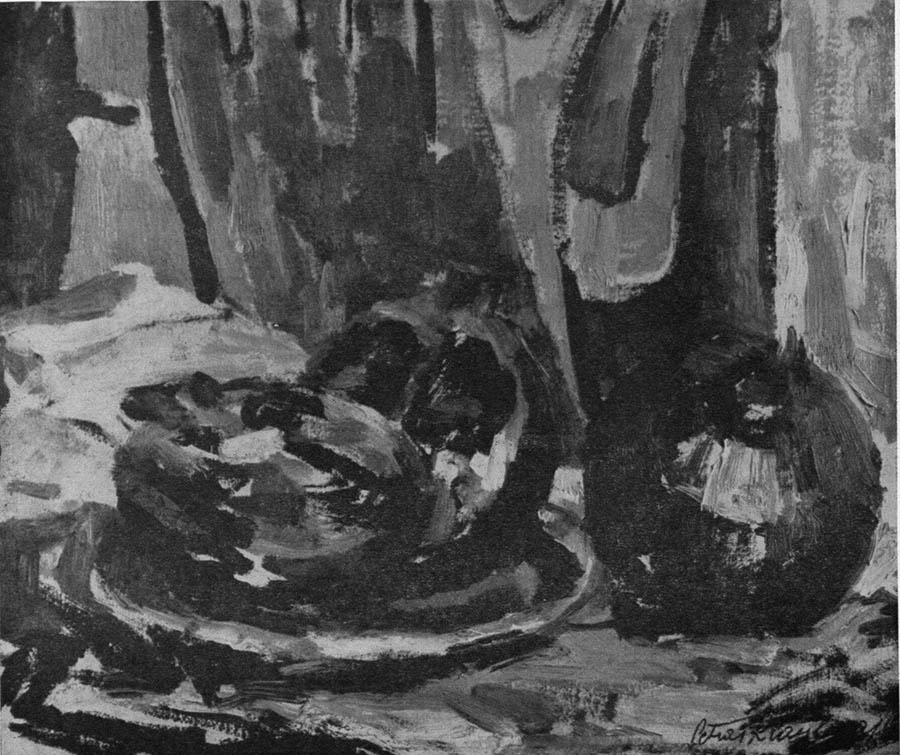
Still Life
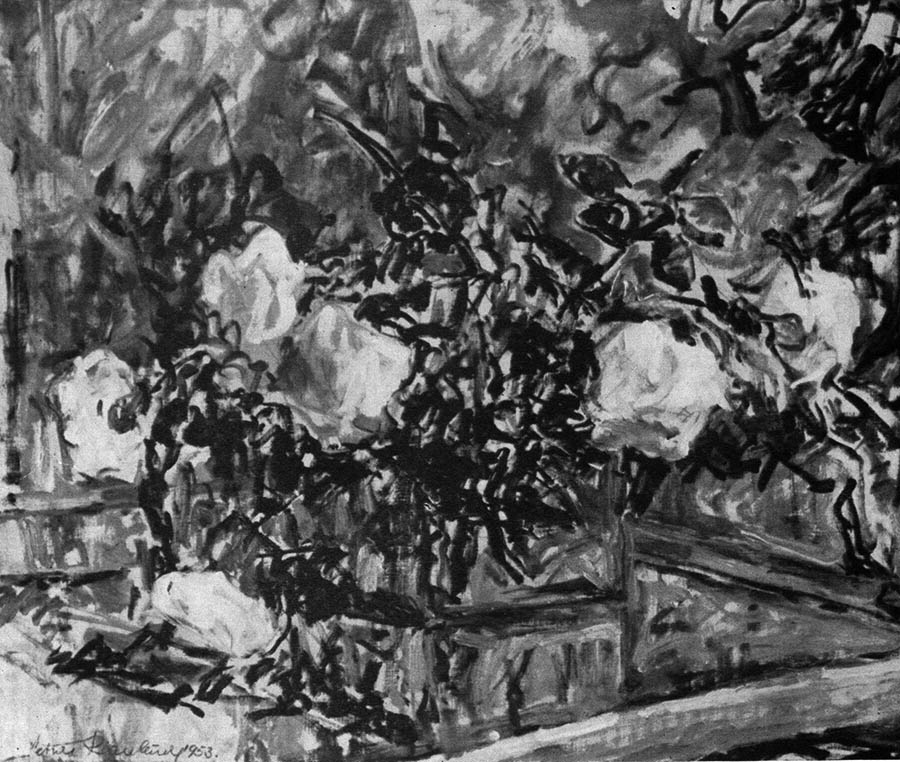
Flowers
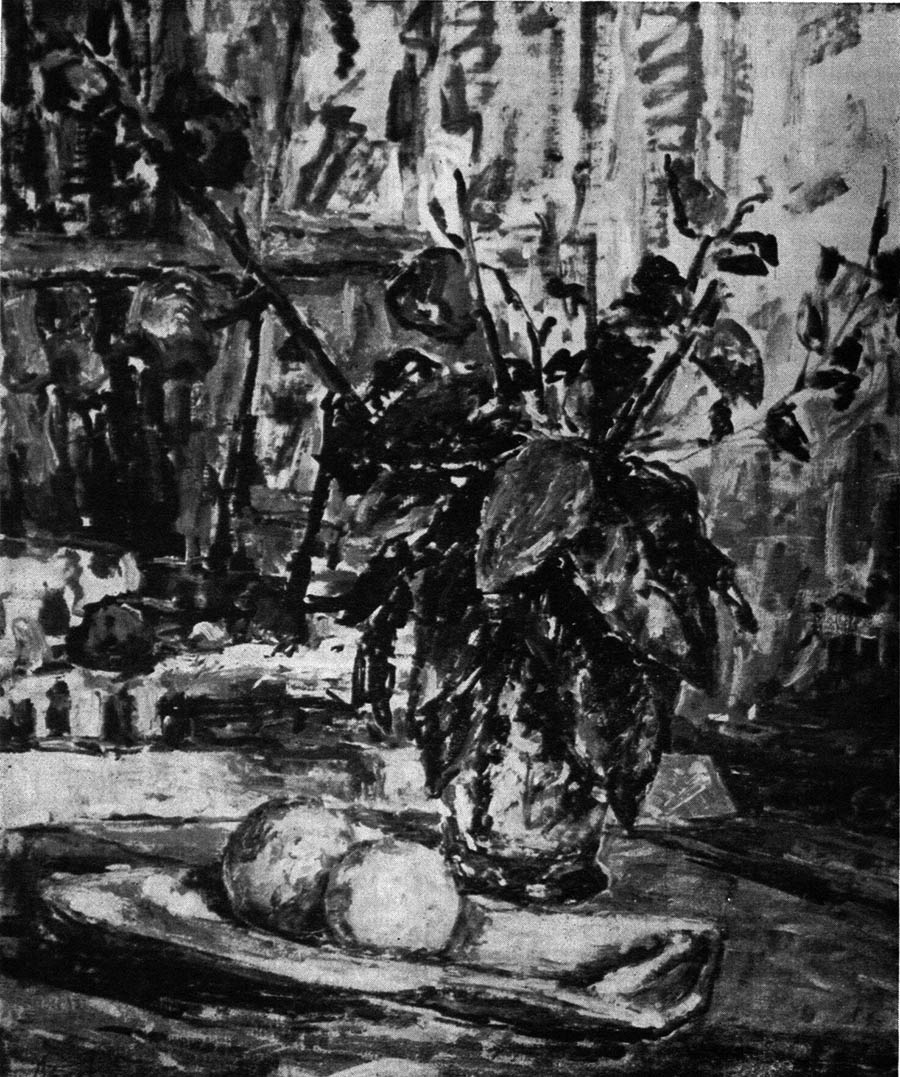
Still Life
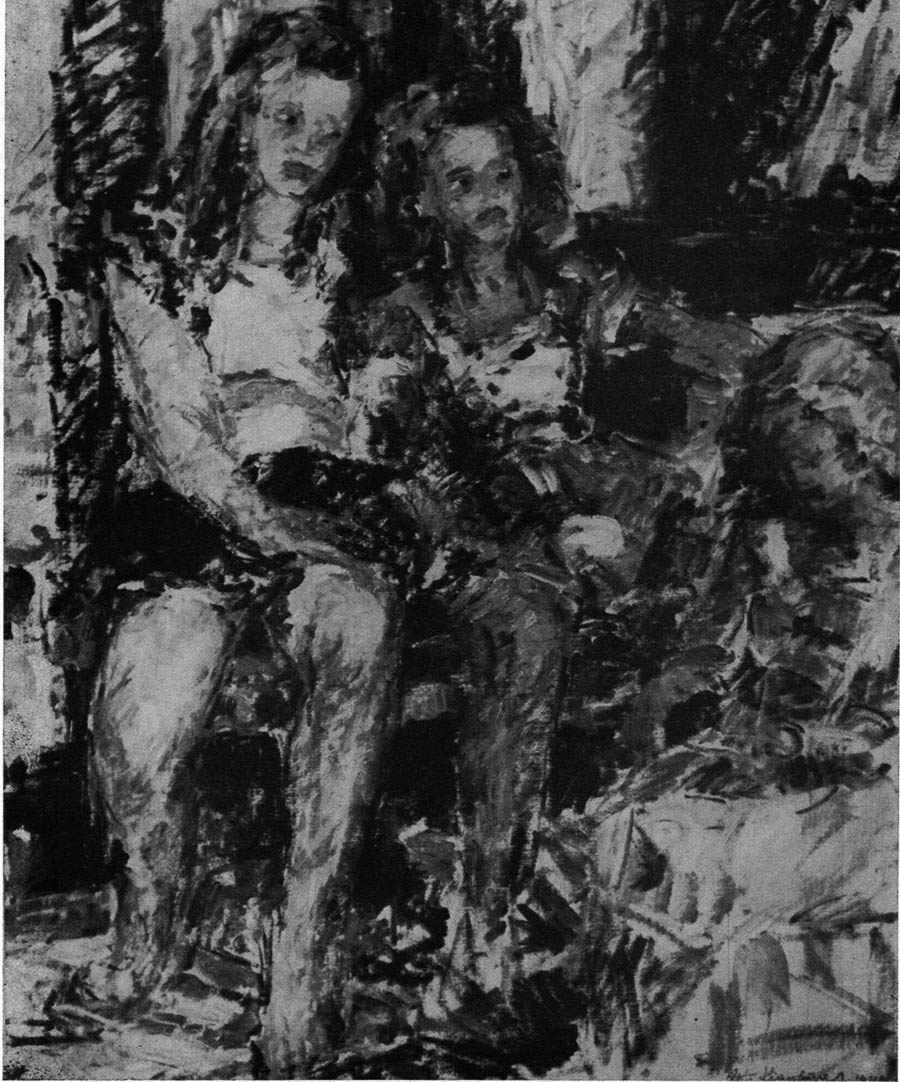
The Girls
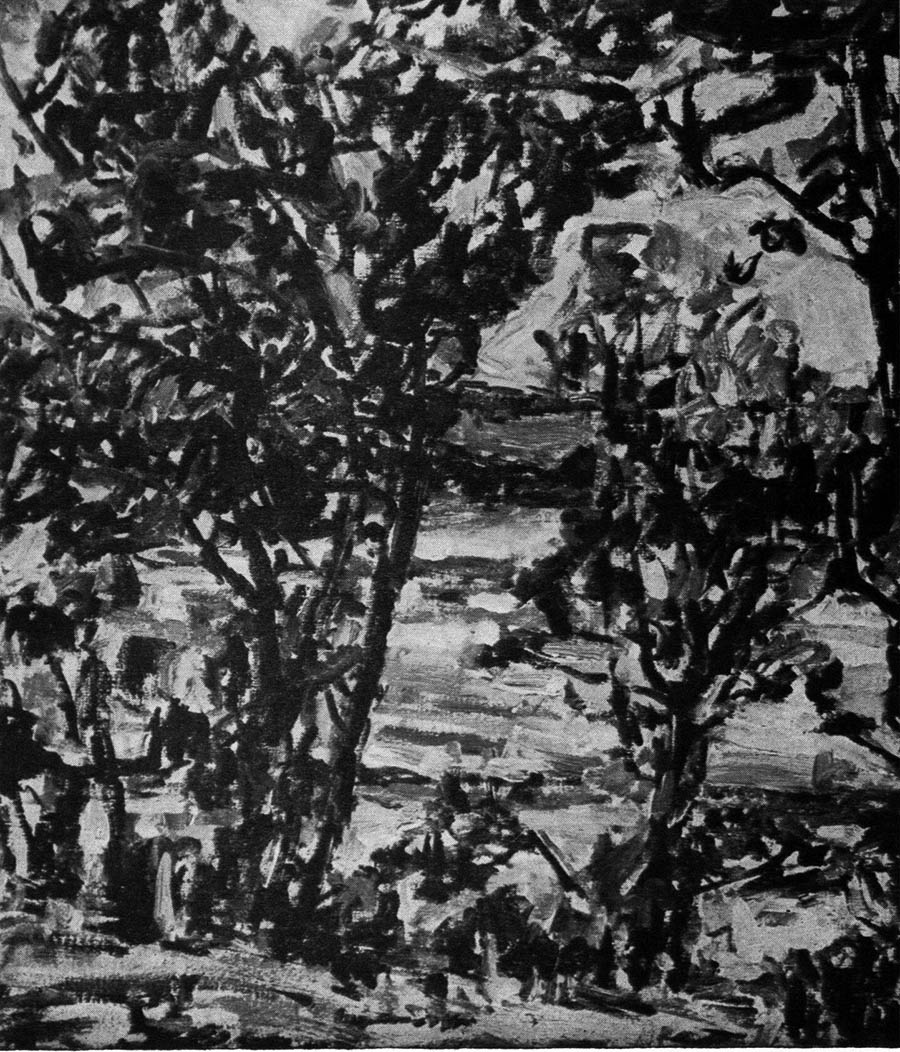
Trees
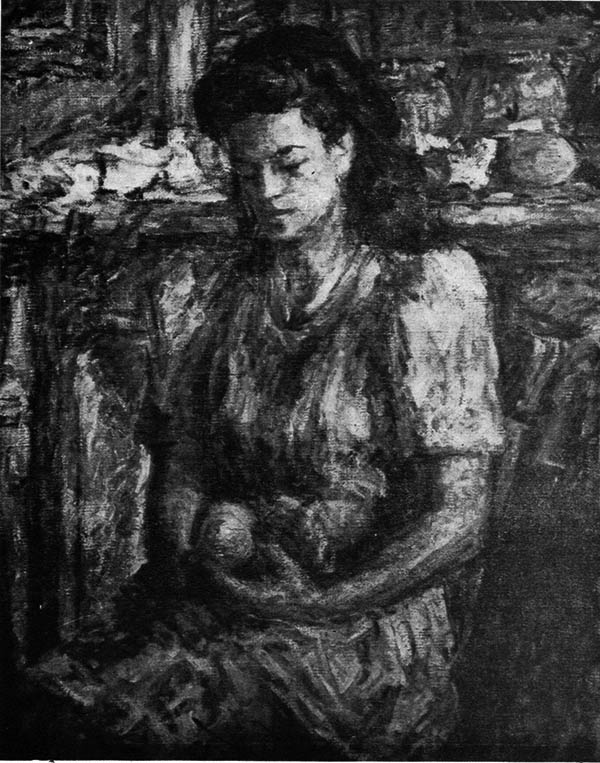
Portrait

Sunset